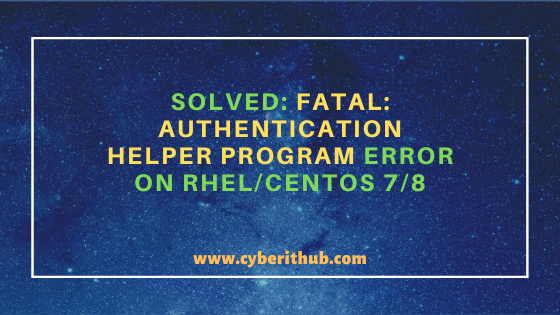Are you facing “FATAL: Authentication helper program /usr/lib/squid/basic_ncsa_auth: (2) No such file or directory” error while trying to setup squid proxy server ? Do you want to Know how to solve “FATAL: Authentication helper program /usr/lib/squid/basic_ncsa_auth: (2) No such file or directory” error ? If yes, then you have come to the right place. Even I was facing this error when I was trying to configure squid proxy server. While checking this error I thought to put all the steps in an article so that it will help you guys also if you are facing the same issue.

Solved: “FATAL: Authentication helper program /usr/lib/squid/basic_ncsa_auth”
Also Read: How to Install and Configure Squid Proxy Server on RHEL/CentOS 7/8
After setting up the Squid proxy server when I restarted the service using systemctl restart squid command then I noticed below error on the output.
[root@localhost ~]# systemctl restart squid Job for squid.service failed because the control process exited with error code. See "systemctl status squid.service" and "journalctl -xe" for details.
To understand more about the error which was causing the service failure I tried to check the status by using systemctl status squid -l command as shown below.
[root@localhost ~]# systemctl status squid -l ● squid.service - Squid caching proxy Loaded: loaded (/usr/lib/systemd/system/squid.service; enabled; vendor preset: disabled) Active: failed (Result: exit-code) since Sun 2020-10-25 15:46:20 EDT; 12s ago Process: 14382 ExecStop=/usr/sbin/squid -k shutdown -f $SQUID_CONF (code=exited, status=0/SUCCESS) Process: 16088 ExecStart=/usr/sbin/squid $SQUID_OPTS -f $SQUID_CONF (code=exited, status=1/FAILURE) Process: 16083 ExecStartPre=/usr/libexec/squid/cache_swap.sh (code=exited, status=0/SUCCESS) Main PID: 11680 (code=killed, signal=TERM) Oct 25 15:46:20 localhost squid[16088]: Authentication helper program /usr/lib/squid/basic_ncsa_auth: (2) No such file or directory Oct 25 15:46:20 localhost squid[16088]: FATAL: Authentication helper program /usr/lib/squid/basic_ncsa_auth: (2) No such file or directory Oct 25 15:46:20 localhost squid[16088]: Squid Cache (Version 3.5.20): Terminated abnormally. Oct 25 15:46:20 localhost squid[16088]: CPU Usage: 0.010 seconds = 0.004 user + 0.006 sys Oct 25 15:46:20 localhost squid[16088]: Maximum Resident Size: 26880 KB Oct 25 15:46:20 localhost squid[16088]: Page faults with physical i/o: 0 Oct 25 15:46:20 localhost systemd[1]: squid.service: control process exited, code=exited status=1 Oct 25 15:46:20 localhost systemd[1]: Failed to start Squid caching proxy. Oct 25 15:46:20 localhost systemd[1]: Unit squid.service entered failed state. Oct 25 15:46:20 localhost systemd[1]: squid.service failed.
Then I went back to my squid configuration file squid.conf and tried to check all the configuration carefully. After few minutes I noticed that the first line of the configuration does not look correct. In the first line, I have mentioned the authentication program path as /usr/lib/squid/basic_ncsa_auth which is not available in my server. Check more on Squid Official Documentation.
auth_param basic program /usr/lib/squid/basic_ncsa_auth /etc/squid/passwords
auth_param basic realm Squid proxy-caching web server
auth_param basic credentialsttl 10 hours
auth_param basic casesensitive off
acl authenticated proxy_auth REQUIRED
http_access allow authenticated
http_access deny all
http_port 9000
In my server, it is available under /usr/lib64/squid/basic_ncsa_auth. So instead of using lib, I was suppose to use lib64 as shown below.
auth_param basic program /usr/lib64/squid/basic_ncsa_auth /etc/squid/passwords
Then I again tried to restart the squid service by using same systemctl restart squid command as you can see below. This time it did not thrown any error on the output.
[root@localhost ~]# systemctl restart squid
So I quickly checked the service status using systemctl status squid command and found to be working fine.
[root@localhost ~]# systemctl status squid ● squid.service - Squid caching proxy Loaded: loaded (/usr/lib/systemd/system/squid.service; enabled; vendor preset: disabled) Active: active (running) since Sun 2020-10-25 15:52:32 EDT; 7s ago Process: 14382 ExecStop=/usr/sbin/squid -k shutdown -f $SQUID_CONF (code=exited, status=0/SUCCESS) Process: 16187 ExecStart=/usr/sbin/squid $SQUID_OPTS -f $SQUID_CONF (code=exited, status=0/SUCCESS) Process: 16182 ExecStartPre=/usr/libexec/squid/cache_swap.sh (code=exited, status=0/SUCCESS) Main PID: 16189 (squid) CGroup: /system.slice/squid.service ├─16189 /usr/sbin/squid -f /etc/squid/squid.conf ├─16191 (squid-1) -f /etc/squid/squid.conf └─16192 (logfile-daemon) /var/log/squid/access.log Oct 25 15:52:32 localhost systemd[1]: Starting Squid caching proxy... Oct 25 15:52:32 localhost systemd[1]: Started Squid caching proxy. Oct 25 15:52:32 localhost squid[16189]: Squid Parent: will start 1 kids Oct 25 15:52:32 localhost squid[16189]: Squid Parent: (squid-1) process 16191 started
One more scenario which I could think of that can cause "FATAL: Authentication helper program /usr/lib/squid/basic_ncsa_auth: (2) No such file or directory" error is that you might not have squid-helpers package installed in your Server which usually gets installed with squid main package. You can easily install this package by using yum install squid-helpers -y command as shown below.
[root@localhost ~]# yum install squid-helpers -y
Popular Recommendations:-
11 Best Python OS Module Examples on Linux
How to Install MariaDB 5.5 Server on RHEL/CentOS 7 Linux with Easy Steps
6 Simple Steps to Change/Reset MariaDB root password on RHEL/CentOS 7/8
Best Steps to Install Java on RHEL 8/CentOS 8
5 Examples to Turn Off SELinux Temporarily or Permanently on RHEL 8/CentOS 8
Best Explanation of Wrapper Classes in Java: Autoboxing and Unboxing with Examples
5 Best Ways to Become root user or Superuser in Linux (RHEL/CentOS/Ubuntu)
